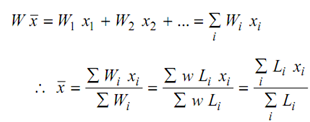Centroid of Thin Wires:
A thin uniform wire bent in a specified shape ABCDE (lying in one plane, XOY) may be divided into a appropriate number of straight lengths for each of which its centroid is known to be at its mid-point.
[Note : 'O' is any arbitrary Origin of Axes in Plane XOY.]
If wire of entire length L is formed of L1 = AB, L2 = BC and so on, with their mass-centres (or C. G.) situated at their mid-points G1, G2 etc., then L = L1 + L2 + ... =  . You may apply Varignon's theorem again as follows :
. You may apply Varignon's theorem again as follows :
Let that the plane XOY is horizontal so that axes OX and OY both lie in it and are horizontal. Supposing the weight of wire as w Newtons/metre length, we have following :
Weight of portion, AB = wL1 = W1
Weight of portion, BC = wL2 = W2 , and so on
Total Weight, W = W1 + W2 + ... =  = w ∑ Li
= w ∑ Li
Letting first moment of all of these weights about axis OY, if the overall mass-centre, we have :

Likewise, considering first moment of weights about y axis

[Note : Similar to C. G. of a thin uniform wire, the concept of centroid of length may be defined. Therefore, the above referred point (x, y) may be said to be the centroid of length ABCDE.]
For irregularly shapes wires, while term L1, L2 etc. occurring in the above expressions become infinitesimally small, the expressions for x¯ and y¯ may be written as,
x¯ =∫ x dL / ∫ dL
y¯ = ∫ y dL / ∫dL
Here, dL is the length of differential element and (x, y) is the coordinates of its centroid.